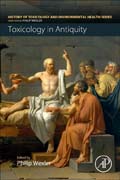
Toxicology in the Antiquity provides an authoritative and fascinating exploration into the use of toxins and poisons in antiquity. It brings together the two previously published shorter volumes on the topic, as well as adding considerable new information. Part of the History of Toxicology and Environmental Health series, it covers key accomplishments, scientists, and events in the broad field of toxicology, including environmental health and chemical safety. This first volume sets the tone for the series and starts at the very beginning, historically speaking, with a look at toxicology in ancient times. The book explains that before scientific research methods were developed, toxicology thrived as a very practical discipline. People living in ancient civilizations readily learned to distinguish safe substances from hazardous ones, how to avoid these hazardous substances, and how to use them to inflict harm on enemies. It also describes scholars who compiled compendia of toxic agents. New chapters in this edition focus chiefly on evidence for the use of toxic agents derived from religious texts. . Provides the historical background for understanding modern toxicology . Illustrates the ways previous civilizations learned to distinguish safe from hazardous substances, how to avoid the hazardous substances and how to use them against enemies . Explores the way famous historical figures used toxins . New chapters focus on evidence of the use of toxins derived from religious texts INDICE: 1. Toxicology in Ancient Egypt 2. The Death of Cleopatra: Suicide by Snakebite or Poisoned by Her Enemies? 3. Mithridates of Pontus and His Universal Antidote 4. Theriaca Magna: The Glorious Cure-All Remedy 5. Nicander, Thêriaka, and Alexipharmaka: Venoms, Poisons, and Literature 6. Alexander the Great: A Questionable Death 7. Harmful Botanicals 8. The Case Against Socrates and His Execution 9. The Oracle at Delphi: The Pythia and the Pneuma, Intoxicating Gas Finds, and Hypotheses 10. The Ancient Gates to Hell and Their Relevance to Geogenic CO2 11. Lead Poisoning and the Downfall of Rome: Reality or Myth? 12. Poisons, Poisoners, and Poisoning in Ancient Rome 13. Murder, Execution, and Suicide in Ancient Greece and Rome 14. Chemical and Biological Warfare in Antiquity 15. Anthropogenic Air Pollution in Ancient Times 16. Poisoning in Ancient Rome: The Legal Framework, The Nature of Poisons, and Gender Stereotypes 17. Asclepius and the Snake as Toxicological Symbols in Ancient Greece and Rome 18. Death by Bull's Blood? in Ancient Greece 19. Drugs, Suppositories, and Cult Worship in Antiquity 20. Kohl Use in Antiquity: Effects on the Eye 21. Gleaming and Deadly White: Toxic Cosmetics in the Roman World 22. Poisonous Medicine in Ancient China 23. The Venomous Virgin: Fact or Fantasy? 24. Mushroom Intoxication in Mesoamerica 25. Entheogens in Ancient Times: Wine and the Rituals of Dionysus 26. Entheogens (Psychedelic Drugs) and the Ancient Mystery Religions 27. Toxicity of Ayurvedic Medicines and Safety Concerns 28. Pearl, an Ancient Antidote of Eastern Origin 29. Beetle and Plant Arrow Poisons of the San People of South Africa 30. Paleolithic Poisons 31. Did Hannibal really poison himself? 32. Rhetoric, Demons, and the Poisoner's Tongue in Early Christianity and Judaism 33. Infamous Female Roman Poisoners: Locusta, Canidia, Martina 34. Bivalent Pharmacology
- ISBN: 978-0-12-815339-0
- Editorial: Academic Press
- Encuadernacion: Rústica
- Páginas: 350
- Fecha Publicación: 01/06/2018
- Nº Volúmenes: 1
- Idioma: Inglés
